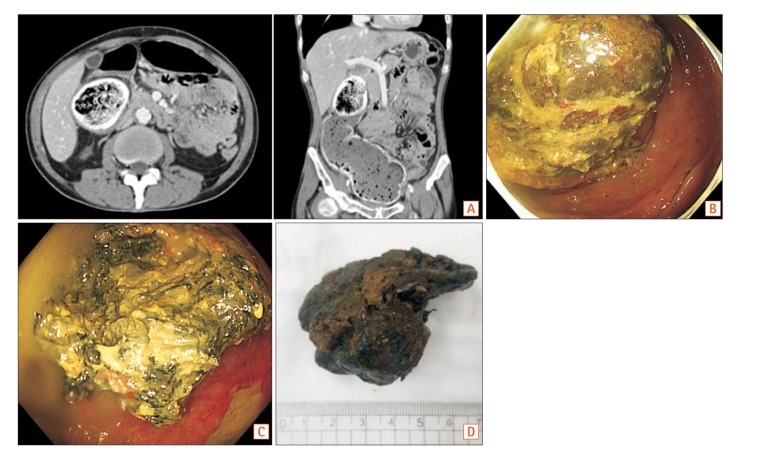

Question: A 61-year-old man visited Inha University Hospital with complaints of right lower quadrant pain and abdominal distension of 3 days duration. He was on hemodialysis with end stage renal disease and was taking clopidogrel, acetylsalicylic acid, atorvastatin and β-blocker due to coronary artery occlusive disease. Physical exam revealed right lower quadrant tenderness, and abdominal CT depicted a ~6 cm sized intraluminal encapsulating mass with a mottled gas appearance at the hepatic flexure and a distended ascending colon filled with stool material (Fig. A).
One day after presentation, colonoscopy revealed a huge, dark-brownish mass at the hepatic flexure (Fig. B) with a surrounding colonic ulcer presumably caused by mass pressure (Fig. C). The mass was removed endoscopically (Fig. D). What is the diagnosis in this case, and what is the proper treatment.
The diagnosis was colonic bezoar with colonic obstruction. In such cases, if an endoscopic approach is unavailable, surgery is considered. Fortunately, in this patient, the bezoar was accessible and could be removed endoscopically. However, due to its large size and hard nature, its removal was time-consuming and laborious. Various endoscopic accessories, such as, a raw-tooth grasper, trapezoid basket, and a polypectomy snare, were used to crush the bezoar and 300 mL of Coca-Cola® (The Coca-Cola Co., Atlanta, GA, USA) was injected to soften remaining bezoar during each removal attempt. In fact, 4 sessions on consecutive days were required to achieve successful removal.
Bezoars are gastrointestinal masses formed by the concretion of inedible or undigested materials within the digestive tract. Intestinal obstruction by a bezoar is rare. It accounts for 0.4% to 4.0% of gastrointestinal obstructions, and occurs mostly in the stomach and/or ileum in the small intestine. Colonic obstruction by a bezoar is extremely rare and usually affects the rectosigmoid junction.123 Bezoars are classified by composition as phytobezoars, trichobezoars, lactobezoars, or pharmacobezoars, but phytobezoars caused by indigestible food are most common.4 Phytobezoars occurs more often in patients who have undergone gastrointestinal surgery or who take drugs that decrease bowel movements, such as, β-blocker. Bezoar can be diagnosed by characteristic CT findings as it is visualized by a well-circumscribed, air-speckled, intraluminal mass. Fecaloma is difficult to differentiate completely from bezoar based on CT findings, but in general, fecaloma, unlike bezoars, calcified encapsulation is not common.5 This case was diagnosed as bezoar because the undigested fiber component was entangled in the core of the mass. Initial colonic bezoar treatment usually involves waiting for spontaneous passage, but if conservative treatment fails, endoscopic or surgical removal is required. In addition, the administration of Coca-Cola® may help soften a bezoar, presumably because the sodium bicarbonate in Coca-Cola® has a mucolytic effect and the penetration of carbon dioxide bubbles into bezoars helps digest concreted fibers.4
In summary, we encountered an unusual case of colonic obstruction caused by a bezoar at the hepatic flexure. The mass was successfully removed endoscopically with the aid of Coca-Cola® dissolution therapy, but required much time and effort. The patient was followed at an outpatient clinic and did not experience recurrence.
Notes
References
1. Law GW, Lin D, Thomas R. Colonic phytobezoar as a rare cause of large bowel obstruction. BMJ Case Rep. 2015; 2015:bcr2014208493.

2. Yoon SS, Kim MS, Kang DY, et al. A case of successful colonoscopic treatment of colonic obstruction caused by phytobezoar. J Korean Soc Coloproctol. 2011; 27:211–214. PMID: 21980592.

4. Chung YW, Han DS, Park YK, et al. Huge gastric diospyrobezoars successfully treated by oral intake and endoscopic injection of Coca-Cola. Dig Liver Dis. 2006; 38:515–517. PMID: 16330268.

5. Aiyappan SK, Ranga U, Samraj A, Rajan SC, Veeraiyan S. A case of fecaloma. Indian J Surg. 2013; 75:323–324. PMID: 24426465.





 PDF
PDF ePub
ePub Citation
Citation Print
Print


 XML Download
XML Download